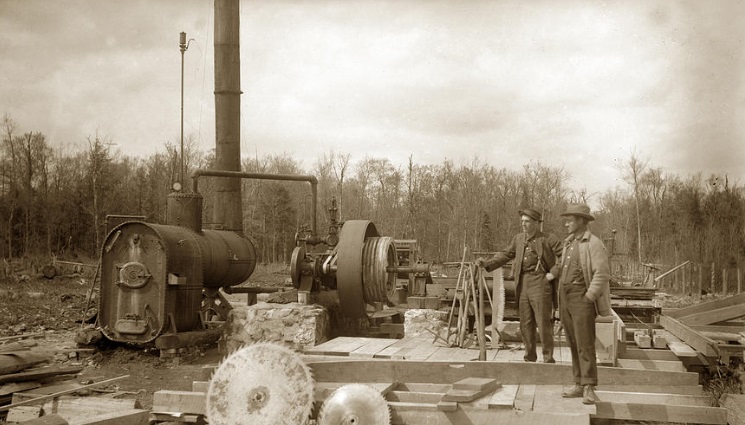Timber Logging
From the late 1600s to around 1930, Stafford County was one of Virginia’s most industrialized counties. Major industries conducted here included sandstone quarrying, fishing, iron making and forging, timbering, gold mining, pyrite mining, and flour milling.
Logging and sawing lumber commenced shortly after the county was settled in the 1650s and continued as a major industry here until the Great Depression. Early on, trees were felled by men using axes or large two-man saws. Until around 1840, cutting the logs into useable lumber was done by pit sawing or by water-powered mills fitted with saws. Around the 1840s steam power was harnessed to run saws. This dramatically increased the amount of lumber that could be made each day and reduced the number of men required to do it. By about 1850 steam-powered sawmills had been made portable. This major improvement allowed the sawmill to be taken to the timber rather than having to haul logs to the mill. A newspaper advertisement described these sawmills:
Portable Steam Saw Mills. The subscribers are now fully engaged in the manufacture of the above article, and have recently added such valuable improvements that when brought in competition with similar Mills made elsewhere, their great superiority is acknowledged and admitted by all.
Especial pains are taken in their construction in reference to simplicity, durability and safety, and in rapidity of operation they are unequaled. They are so constructed that the motion can be regulated at pleasure and accelerated or retarded in an instant, and at the slightest touch.
Such is the immeasurable superiority of the Portable Circular Saw Mill, that all others, however great their advantages, must be entirely superseded in a few years.
To enumerate all the advantages of this Mill over the Water Saw Mill, would occupy too much space. The facility alone of moving from place to place, thus moving the Mill to the timber instead of the timber to the Mill, is of incalculable value. The amount of work performed by them is three times as great as can be accomplished with the Upright Saw—6000 feet of board per day being no unusual or uncommon task. The slabs in sawing furnish always a super abundance of fuel.
In the manufacture of our engines, we construct them with a double crank, so that by the use of an additional fly wheel, they can be made to drive with perfect facility any other machinery that may be desired.
All orders executed in the very best manner, and with the utmost dispatch.
Scott & Herndon
Hope Foundry, Fredericksburg, Va.
The availability of the steam-powered mills greatly encouraged the timber industry in Stafford. In addition to lumber for use in buildings and boats, this industry also provided thousands of railroad ties for use in this county as well as for railroads all along the Atlantic seaboard. From the 1840s until the 1930s, nearly every able-bodied man in Stafford shaped logs into railroad ties. Using a tool called a broad ax, he carefully chopped off the round sides to make ties of uniform thickness and length. In the 1920s a man could expect to earn 25 cents for each railroad tie he cut. Many of the railroad ties were shipped out of Stafford on sailing vessels called longboats. These landed at the wharves at Coal Landing and Aquia Landing on Aquia Creek and Crow’s Nest and Belle Plains on Potomac Creek. The ships were loaded with as many ties as they could hold without capsizing.
Another important use for Stafford’s timber was for firewood. From around 1890-1930, tens of thousands of tons of firewood were shipped from these same wharves. Sailing vessels carried the wood to Alexandria, Washington, Baltimore, and Philadelphia where it was used to heat homes, businesses, and public buildings.
Great quantities of timber was cut from the northern part of Stafford that is now the Marine Corps reservation as well as from Crow’s Nest and from the area on the south side of Potomac Creek and in the vicinity of Belle Plains. Marlborough Point was also heavily timbered as was the area around Ramoth Baptist Church. This last region was long referred to as “the Woodcutting.”
Many county men were involved in the timber industry. Some of them did it on a very small scale, supplementing the income they made farming. Others, such as Capt. Wesley Knight (1846-1937) and his brother Uriah Knight (1853-1914) and Simeon Chancellor Peyton (1829-1905) and Henry Thompson timbered on a very large scale. This required hiring many men to cut the timber and run the sawmills and housing and food for those workers who didn’t live close by. Most of the larger timbermen also invested in their own sawmills and ships to haul the wood to cities where it could be sold.
The timber industry thrived from the mid-1600s until the outbreak of the Civil War in 1861. Occupation of Stafford by Union troops resulted in the cutting and loss of nearly every tree in the county. Not until around 1890 were the trees large enough to begin cutting again on a commercial basis. From that time until the Great Depression, nearly every able-bodied man in Stafford County had some involvement in timbering. After the Depression, the timber business never regained its former importance.


